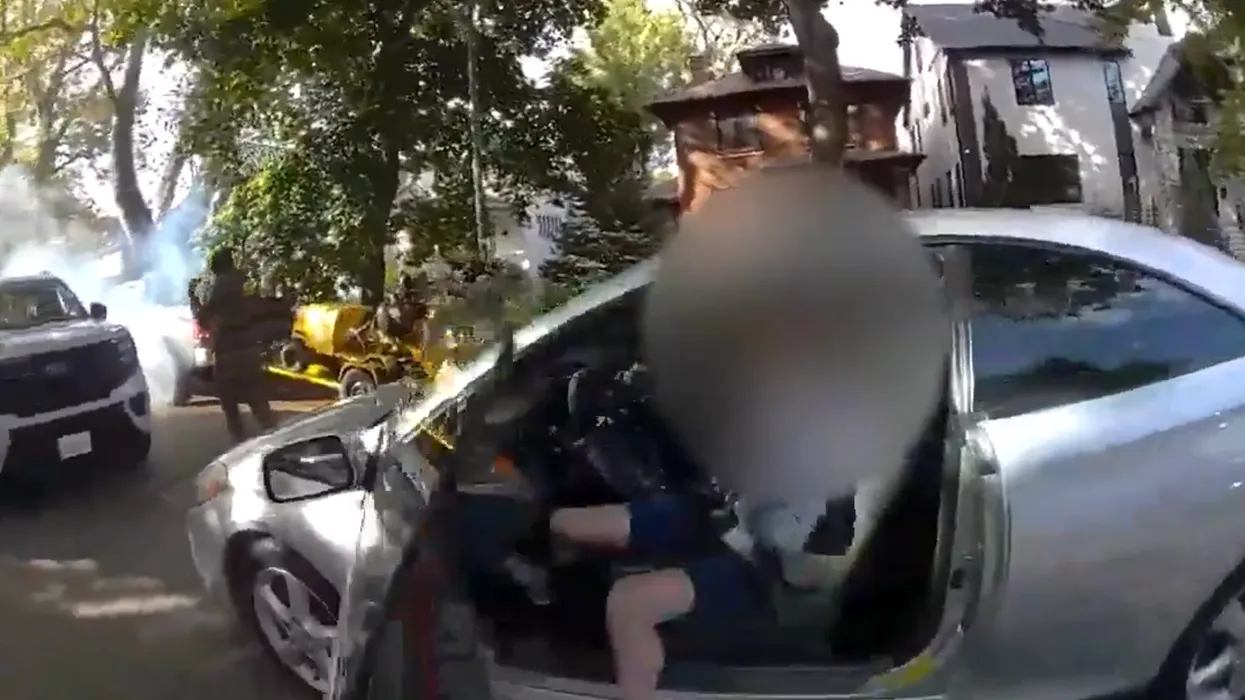Some customers walking out of the West Hollywood Trader Joe’s wear an annoyed look on their face, and it has nothing to do with rising grocery prices.
The source of the irritation is a small blue box installed in a stairwell leading to the market, the latest tactic used by property owners to deter unhoused people from camping out in the area.
The motion-activated device chatters like a loud, anxious cricket as people pass by the shopping center.
“It’s so annoying,” Jeffrey Howard said as he left the market with his groceries. “It’s like an alarm from a smoke detector that you’re just waiting for somebody to turn off.”
Another shopper, Travis Adam Wright, said he thought the device was a poor response the homeless problem and a bad look for West Hollywood.
“It feels indicative to a jerk’s first response to people living on the street,” he said.
The blue box joins a growing list of deterrents deployed by Southern California business owners and property managers who have taken matters into their own hands to address the homeless crisis.
In downtown Los Angeles, a property owner blasted the monotonous children’s song “Baby Shark” to deter camping last month. In 2023, L.A. Metro began blaring loud classical music as part of a pilot program to drive away homeless people from subway stations.
But the blue box, dubbed the BlueChirper, emits a racket that is devoid of rhythm. The chirping sound is triggered by the passing of anyone under the motion-sensing device, regardless of their intention.
A spokesperson for the city of West Hollywood said a code enforcement officer is scheduled to visit the stairwell to see if the device complies with the local noise ordinance. If there is a violation, the city will recommend alternatives.
West Hollywood spokesperson Joshua Schare said the chirping device is not in line with the city’s response to the homeless population, which includes having nonprofit organizations provide outreach services.
The property management company at the shopping center learned about the device through other news stories and installed it several weeks ago. The company said it is testing out the device, but so far the results seem positive.
“We are all cognizant of and concerned about the care of our homeless population,” Investors’ Property Services President Robert Warren III said via email. “On the other hand, we have a responsibility to work to provide clean and safe access to and throughout this shopping center.”
The chirper represents one of the not-so-subtle ways property owners and others are making public places feel unwelcome to the unhoused.
Armrests protruding from the middle of a bus bench or park bench are an understated way of keeping people from lying down, said Esther Margulies, professor with the USC School of Architecture and Dornsife Spatial Sciences Institute.
Margulies said she understands the frustration property owners encounter when people are trying to seek shelter around their buildings. But she said devices like the chirper represent the private sector trying to solve the problems that should be addressed by local government.
“By creating these kinds of hostile elements that take people away from shelter or just move them around, we’re not treating the root cause,” Margulies said. “We are diminishing and demeaning the quality of our public environment, because we’re responding to this social and economic problem without treating the cause.”
The latest data show there were 75,312 homeless people in Los Angeles County in January 2024, roughly 200 fewer than in the previous year, but about 6,100 more than in 2023.
In March, Los Angeles County Supervisors approved a $908-million-funding budget for homeless services, including the first rollout of funding under the Measure A sales tax intended to address the city’s homeless problem.
The BlueChirper device retails for $400 and was invented out of frustration.
Stephen McMahon invented and first deployed the device outside his Santa Monica condominium complex storage area after a break-in and a neighbor with her infant daughter was assaulted by two men.
McMahon initially proposed a solution to his homeowners association board to deter trespassers. Now the retired director of photography is fielding orders for the BlueChirper after teaching himself how to make a circuit board that can emit the annoying sound and flash a blue light.
He says the device works as intended at his condo complex.
The majority of sales are from women younger than 40 who like the “non-aggressive aspect” of the device, McMahon said.
He wishes he didn’t have to resort to this tactic, but feels there has been little done to address the homeless crisis in Los Angeles County.
“I don’t want to punish anybody. I just want them to go somewhere else,” he said.
In West Hollywood, local merchants say the device has managed to deter people from camping in the stairwell that leads to Santa Monica Boulevard and several eateries.
The chirping is hardly noticeable at a nearby pizza restaurant with the doors closed. But four businesses away at Waxology Weho, employee Roxanne Moreno said she can hear the sound and finds it embarrassing that this is the solution used to address the homeless problem in the area.
“These people are patrons too and this comes across as another step to criminalize homelessness,” Moreno said. “What is the end goal for all of this?”
The post West Hollywood shopping center installs chirping device to discourage homeless from camping out. Will it work? appeared first on Los Angeles Times.




